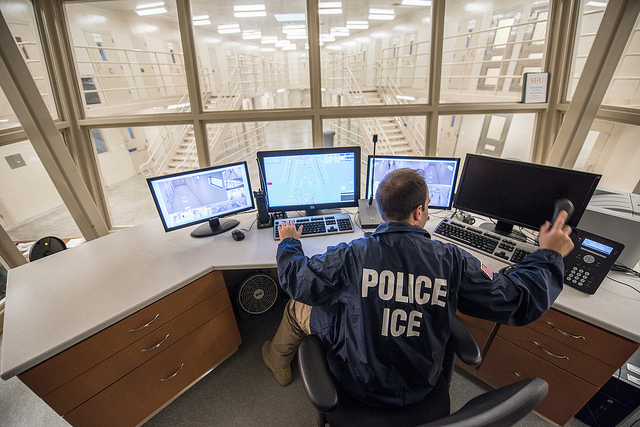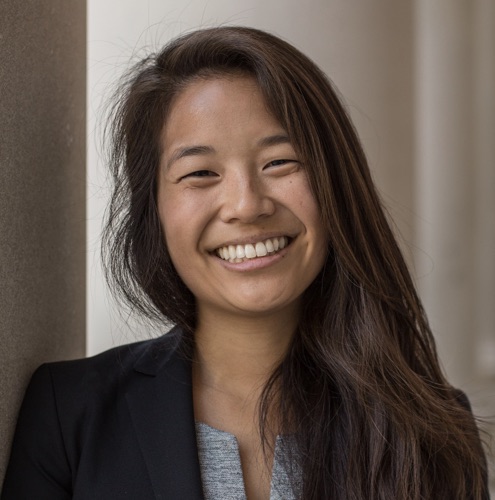New York Lawsuit Challenges Replacement of Immigration Court Hearings with Video Technology
In the latest salvo in a long debate over the use of video teleconferencing (VTC) technology in immigration courts, several legal aid organizations filed a class-action lawsuit on Feb. 12 in New York challenging the U.S. Immigration and Customs Enforcement (ICE) practice of denying in-person hearings to immigrants.

Published by The Lawfare Institute
in Cooperation With

In the latest salvo in a long debate over the use of video teleconferencing (VTC) technology in immigration courts, several legal aid organizations filed a class-action lawsuit on Feb. 12 in New York challenging the U.S. Immigration and Customs Enforcement (ICE) practice of denying in-person hearings to immigrants. The government and other proponents of remote adjudication by video argue that it improves efficiency, while skeptics worry about how it affects judges’ ability to evaluate credibility and immigrants’ ability to present their cases. There have been several legal challenges to the practice since it was introduced in 1996, though this most recent one is the largest and most sophisticated.
Immigration court proceedings have traditionally taken place in courtrooms. However, as dockets have grown and costs have ballooned, the government has increasingly explored methods of reducing the expenses associated with such proceedings. The Immigration and Nationality Act (INA) was amended in 1996 to give immigration judges discretion to conduct removal proceedings via VTC. The agency’s regulations treat video hearings as interchangeable with in-person ones, and the Department of Justice encourages immigration judges to make use of this technology, emphasizing that it is an “effective and efficient” way to conduct hearings.
However, some experts have expressed concerns about the efficacy of proceedings conducted through VTC. A study from 2015 published in the Northwestern Law Review, which analyzed the impact of VTC on outcomes, found that respondents appearing by video were less likely to retain counsel and pursue relief from deportation—and thus were more likely to be deported. The Government Accountability Office’s 2017 report on the issue cited court officials, experts and stakeholders who were concerned that VTC creates challenges in holding hearings, especially merits hearings, because of technical difficulties, confusion by noncitizens appearing in court without an attorney, and complication in translation services. Similarly, a 2017 report commissioned by the Executive Office for Immigration Review, the office within the Justice Department that operates the immigration courts, found that judges have difficulty interpreting body language and nonverbal communication over video feed, and that faulty VTC could be so disruptive to cases that “due process issues may arise.”
The government’s increasing reliance on VTC is inextricable from its reliance on detention as an immigration enforcement tool. Virtually all of the respondents who appear by video are detained, whereas nondetained persons appear in court in person. An active district court case from North Carolina illustrates the tight connection between detention and VTC: Immigration judges in Charlotte were refusing to exercise jurisdiction over detainees’ requests for bond hearings in situations where the immigrant had an upcoming transfer to another detention center. These judges justified the denials partly on the basis that courtrooms lacked VTC capability, and did not even mention the possibility of an in-person hearing, implying that detained immigrants get a video hearing or none at all. As a result, the plaintiffs spent several additional weeks in detention before having a hearing to determine whether they could be released from custody. (The district court held that the judges had properly exercised their discretion in declining to take jurisdiction, and the case is currently being appealed to the U.S. Court of Appeals for the Fourth Circuit.)
The New York Lawsuit
On June 27, 2018, ICE’s New York Field Office announced a new policy of allowing detained immigrants to attend their removal proceedings only via video teleconferencing. This policy was issued without warning, in response to protests relating to President Trump’s family separation policy occurring outside of Varick Street Immigration Court. According to the plaintiffs, ICE’s public justifications for keeping the policy in place have shifted among employee safety, public safety, cost effectiveness and efficiency. (The lawsuit alleges that these explanations are mere pretext for a broader attempt to deny noncitizens due process within the immigration system.)
On Feb. 12, the Legal Aid Society, the Bronx Defenders and Brooklyn Defender Services, which provide free guaranteed representation to detained individuals in removal proceedings under the city’s New York Immigrant Family Unity Project (NYIFUP), filed a class-action lawsuit, seeking an injunction against the New York Field Office’s new policy. Seven detained or formerly detained noncitizens who were denied the opportunity to appear in person at their removal hearings serve as individual named plaintiffs and class representatives. The three legal services organizations serve as additional organizational plaintiffs.
The suit alleges violations of class members’ First Amendment rights to access the courts and Fifth Amendment due process rights as well as violations of provisions of the INA guaranteeing fair hearings and access to counsel during removal proceedings and the Rehabilitation Act, which requires reasonable accommodations for those with disabilities. Both the class members and the organizational plaintiffs also allege violations of the Administrative Procedure Act, through promulgation of an arbitrary and capricious policy.
The alleged injuries fall into four categories. First, the complaint alleges that each facility that holds immigration detainees does not have enough VTC lines to accommodate all the hearings that need to take place at once. This shortage, in conjunction with the tendency for the technology to malfunction or fail, has allegedly led to unnecessary adjournments. As a result, individuals are required to stay in detention for many more months while waiting for their next scheduled hearing than they otherwise would if their cases had gone forward.
Second, even if there were enough VTC lines to handle the required caseload, plaintiffs allege that the technology itself has inherent limitations. The lawsuit says that, because video feeds can show only a small slice of the courtroom, the noncitizen participating via video has a hard time following what is happening in the proceeding, much less interjecting and objecting. This is compounded by the difficulty of live translation using video feed, in which audio quality is often low and conveying who is saying what can be even more confusing. Plaintiffs also claim that it is nearly impossible to interrupt proceedings to have a confidential attorney-client conversation, as this would require everyone else in the courtroom to vacate, and because the detainee is often being supervised by a jail employee.
Third, immigration judges have a much harder time making credibility determinations by video, as compared to in person. Blurry images, fuzzy audio and the presence of ICE officers in the detainee’s VTC room can alter the way a detainee appears to a judge. This has an especially negative impact on detainees with disabilities, a proposed subclass within the lawsuit, as judges have a much harder time identifying disabilities through video feed.
The fourth and final category of injury involves access to counsel. New York City began administering the NYIFUP in 2014. The program provides publicly funded attorneys for detained immigrants in removal proceedings. Since the program began, attorneys from the Legal Aid Society, the Bronx Defenders and Brooklyn Defender Services have provided intake for potential clients, screened them for relief eligibility and prepared them in private rooms at Varick Street Immigration Court immediately prior to their initial hearings. However, under the new policy, attorneys cannot meet clients at court. Rather, they need to travel to the jails, or convince the jails to allow them to use the VTC lines when they are not otherwise occupied. During hearings, attorneys must be present at immigration court and thus cannot meet in person with their clients. It is also almost impossible to comprehensively intake unrepresented individuals, screen them for relief and obtain signed waivers from them to access their case files before their initial hearings if those individuals are not physically present in the court. The plaintiffs allege that these limitations have caused injury both to the detained class members and to the organizational plaintiffs, who have now expended many more resources, for worse outcomes.
Previous Challenges
There have been several challenges to video teleconferencing in other federal circuits, all cases brought by individual plaintiffs arguing that the use of VTC is itself a violation of the fundamental due process requirement of an opportunity to be heard “at a meaningful time and in a meaningful manner.” The courts have consistently rejected these broad constitutional challenges, while generally acknowledging the possibility that use of the technology could lead to Due Process Clause violations in individual cases.
For example, in Rusu v. I.N.S., the U.S. Court of Appeals for the Fourth Circuit held that the statute authorizing video hearings does not contravene the Due Process Clause, but expressed concern that the use of this new technology may make it difficult for judges to properly make credibility determinations, and for lawyers to communicate effectively with their clients. The respondent in this case, however, had not been prejudiced by having to appear through VTC, meaning that the use of the technology did not materially affect the outcome of his case. The court looked at the merits of his asylum claim to reach this conclusion, finding that the facts as developed in his video hearing showed that he would have lost his case even if the hearing had happened in person. The court was unimpressed by the obvious communication difficulties, with the hearing transcript reflecting 132 instances where the respondent’s statements were marked “indiscernible.”
In Rapheal v. Mukasey, the Seventh Circuit found that the use of VTC may have materially altered the outcome of the petitioner’s immigration case in that it led to a denial of her statutory right to examine evidence, while similarly rejecting the notion that Congress’ authorization of VTC hearings is in itself unconstitutional. Specifically, she had been unable to examine a key piece of evidence the government introduced in the courtroom while she sat in a distant detention center, so the appeals court ordered a new trial before the immigration judge.
The Second Circuit, where this most recent lawsuit was filed, has dealt with one other due process challenge to the use of VTC in immigration court, although that case dealt with witness testimony by video in a hearing where the respondent appeared in person. In Aslam v. Mukasey, the court held that the respondent was not prejudiced by the introduction of a government witness’s video testimony because he had full opportunity to cross-examine that witness and because the judge had offered to transfer the case to an immigration court where the witness could appear in person, an offer the respondent declined.
Conclusion
The New York lawsuit differs from earlier cases in several respects. None of the previous cases involved a class-action challenge, and none dealt with a blanket governmental policy of refusing to produce any detainees for in-person hearings. By challenging ICE’s policy rather than the statute that authorizes the use of video teleconferencing, the plaintiffs are also able to bring claims under the Administrative Procedure Act and the Rehabilitation Act that weren’t available in previous cases.
The question of whether VTC use compromises immigrants’ right to consult with an attorney, which the Rusu court identified as a possible source of due process violations, is starkly presented here. The three organizational plaintiffs argue that their work has shown what full and fair hearings for immigrants actually look like: Before the NYIFUP, detained immigrants won their cases only 4 percent of the time, but with representation, they have won 48 percent of cases. NYIFUP’s model relied on in-person interactions with clients in court, and ICE’s policy has ended this by forcing attorneys either to travel far outside the city to county jails or to meet with clients over VTC in the presence of ICE officers and court personnel. ICE’s action thus could be seen as a direct attack on this publicly funded initiative to provide representation to detained immigrants.
If the plaintiffs in New York can show that they were prejudiced because their case outcomes were materially affected by the use of VTC, or if the court finds that the ICE New York Field Office’s policy barring in-person hearings violates the class members’ constitutional rights, then the New York immigration court may find itself rehearing a lot of cases.



.png?sfvrsn=48e6afb0_5)

